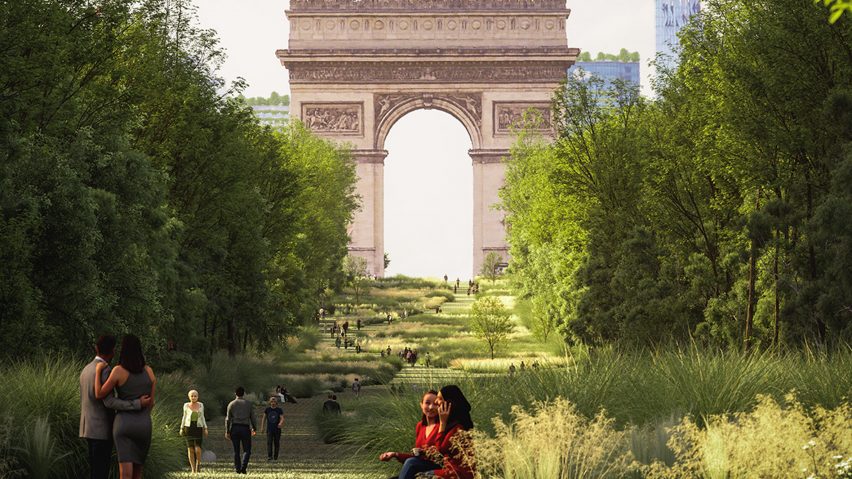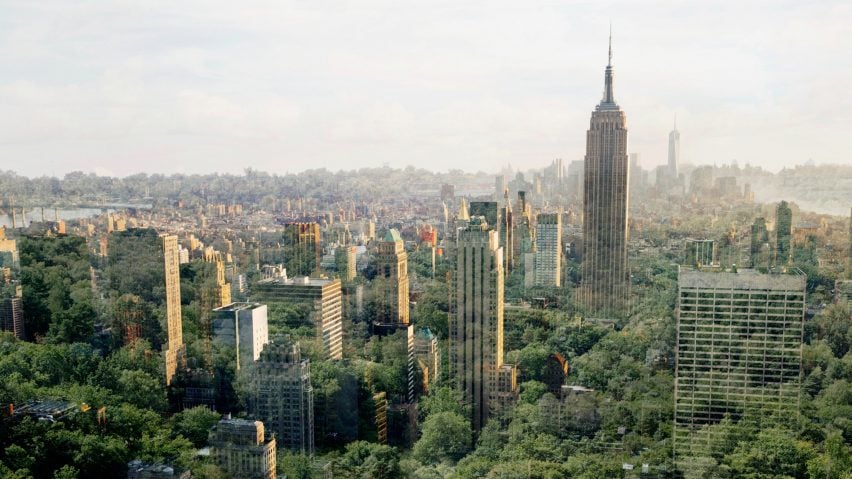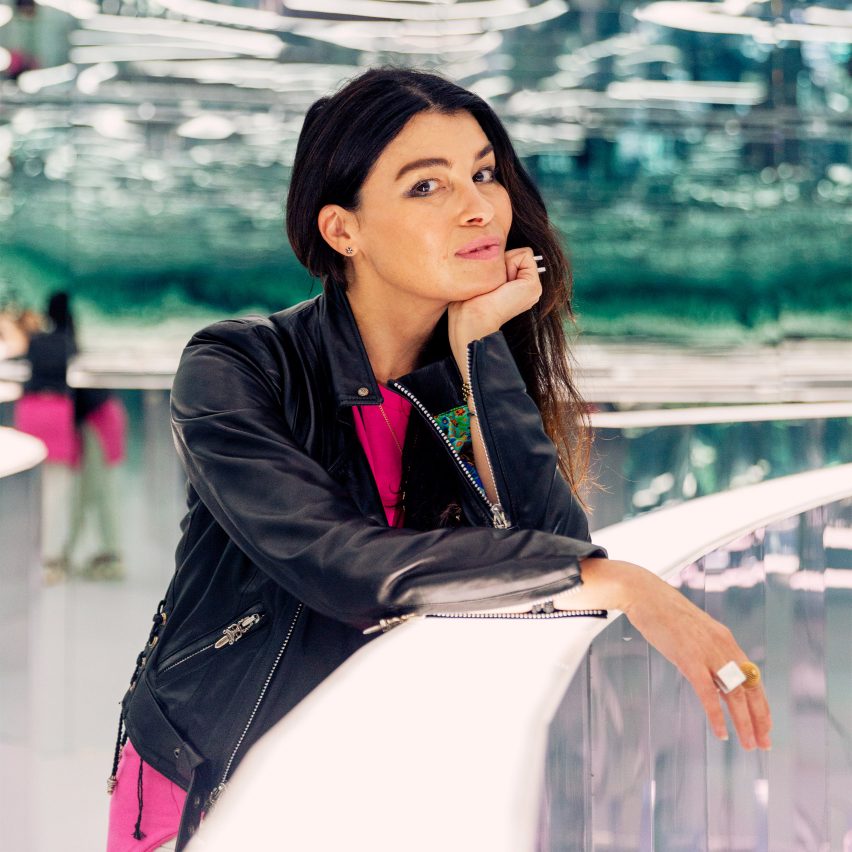
"It's 1 November 2036 and every city has swapped cars for trees" says Es Devlin
In the first of 15 manifestos written for the Dezeen 15 digital festival celebrating Dezeen's 15th birthday, Es Devlin imagines looking back from 15 years in the future at the positive progress made since the COP26 climate conference.
In her vision, world leaders agreed upon a raft of measures to reduce emissions and improve life in cities, including replacing cars with trees.
Meanwhile, architects and designers have all signed an oath promising "to do no harm to the planet as they practice".
The Dezeen 15 festival features 15 manifestos presenting ideas that can change the world over the next 15 years. Each contributor will also take part in a live video interview.
See the line-up of contributors here and watch Devlin's video interview live on Dezeen later today.

Swap cars for trees
Imagine a possible future. It’s 1 November 2036 and every city centre on the planet has swapped parked cars for planted trees. Every city centre has been pedestrianised and optimised for cycles.
Every parked car has been replaced with a planted tree. Every car park has become a forested park. Every new and remodelled building has been designed according to vertical-forest principles with two trees planted for every human inhabitant.
Tree canopy shade has improved energy efficiency by providing shading from the sun and insulating against cold. All buildings are now powered by renewable energy. People and goods move around the city centres along tree-lined pathways on foot, on cycles, using cycle-shares, e-bikes, e-scooters, electric mobility scooters, trams, electric buses and subways.
Amazon has calibrated its algorithms to optimise the delivery of goods to city centres in as few trips as possible. Algorithms also calibrate waste-repurposing services: every time a new product is bought, a plan and service for its full lifespan is incorporated in the transaction.
Every city in the world has achieved 50 per cent tree coverage. City space is shared equally between people and trees
Designers of all products and systems have signed up to a code of conduct, like a Hippocratic oath in medicine or an ethical code of practice in law and accounting, to aim to "do no harm" to the planet as they practice, to engage in circular design principles, aiming to account for the entire lifespan of every product they design.
Every city in the world has achieved 50 per cent tree coverage. City space is shared equally between people and trees. The reduction in car use and increase in walking and cycling has led to increased fitness levels and decreased obesity levels. Reduced pollution levels have led to a decrease in asthma cases.
Exposure to phytoncides – the essential oils released by trees – has increased immunity to viruses, improved people’s sleep and decreased levels of depression and stress.
The increased tree canopy has mitigated the urban heat island effect. The highest summer daytime temperatures have decreased. Air-conditioning use has been reduced. Flooding heights have been reduced. CO2 levels have been reduced. Pollution particles and the diseases and deaths associated with them have been reduced.
Essential workers have moved into city centres through rent-to-buy schemes in intelligently designed micro-apartments. People meet on the park-like streets under the shelter of trees, which have attracted a diverse range of species into city centres.
People shop and eat plant-based, seasonal, locally sourced food from street kitchens serving healthy and varied cuisines prepared by chefs from a growing population of people who have moved to London from a wide range of countries following the reversal of Brexit and the development of inclusive strategic immigration policies.
People shop and eat plant-based, seasonal, locally sourced food from street kitchens
Back in 2021, three million cars in London used to be parked for on average 95 per cent of the time. On-street parking used to take up the equivalent of ten Hyde Parks, while only 56 per cent of Londoners owned a car and 28 per cent of the 87,000 Uber cars in London used to circle the streets without passengers, waiting to be allocated a ride.
Back in 2021, half of all car trips made in the USA were under three miles and 70 per cent of cars carried only one person. The average car speed in Beijing and Paris was 7mph – slower than a horse and cart.
Back in 2021, cars contributed 23 per cent of global CO2 emissions. It was safer to cross the ocean than to cross an eight-lane US highway on foot. 1.3 million people per year died in car accidents. Black people were killed twice as often as white people.
Car ownership used to cost the poorest Americans 32 per cent of their income while 50 per cent of Americans didn’t own a car. Seven million people died each year from air pollution.
Back in 2021, on 1 November, a group of leaders from 197 countries gathered in Glasgow at COP26, the 26th UN climate change conference. We realised that what was decided that week would determine the destiny of humans on the planet.
We realised that decisions that would prevent the extinction of humans in the future would also lead to more equitable, just and joyful lives for humans now, re-connecting them with one another and with the rest of the biosphere.
Designers have signed up to a code of conduct to "do no harm" to the planet as they practice
We realised that two-thirds of humans would be living in cities by 2050 and that decisions which affect the quality of human and non-human life in cities would be central to determining the future of the species and the planet.
We realised that if humans, while living in ever more populated cities, were able to reconnect with the rest of the biosphere and redefine our sense of identity and self-worth in relation to nature and one another, we might become happier in ourselves.
And if humans felt more complete in ourselves and within the context of the more-than-human world around us, we might begin to break free from the extractive, wasteful consumer cycle in which we had become enmeshed.
We realised that, in the words of American environmentalist Paul Hawken, climate change is not happening "to" us but "for" us, to guide us towards a more just and equitable mode of life. We realised that what we design decides our destiny.
City leaders had witnessed car-free city centres during the coronavirus pandemic lockdowns of 2020 and 2021, they had seen streets take on new meanings as restaurants filled the streets in Soho and children cycled around the Arc de Triomphe
As cities reopened, urban planners were quick to add new cycle lanes and convert parking spaces into outdoor restaurants while a section of The Strand in London was immediately pedestrianised and planted with trees.
Of course, there was resistance from residents and businesses, just as there had been huge resistance to smoking bans
Oslo had already pedestrianised its city centre in 2019, providing grants for electric bikes, increasing safe cycle areas and public transport infrastructure. Barcelona increased its pedestrian "superblock" areas incrementally, spending 38 million euros in 2022 to create 16 acres of new city-centre green space.
York became the first car-free city centre in the UK in 2023. Helsinki became car-free in 2025 by introducing a revolutionary "mobility on demand" system. Birmingham, Amsterdam, Bogota, Paris, New York, London, Seattle and Hamburg all followed soon after.
City leaders carried out their ambitious tree-planting pledges, planting a diverse range of varieties of climate-resistant trees, and investing in the maintenance and care of them to ensure they flourished.
Of course, there was resistance from residents and businesses, just as there had been huge resistance to the smoking bans that spread across the globe from 2004. At the time none of us could imagine pubs, restaurants and workplaces being smoke-free. Look how fast smoking inside became de-normalised.
It’s November 2036, the streets of city centres are full of trees not cars. We imagined it in 2021 and now it’s hard to imagine it being any other way.

British artist and designer Es Devlin began her practice in theatre and live music working with artists including Beyonce, Travis Scott and The Weeknd
She creates large-scale sculptural installations and performances which aim to shift the viewer's perspective. Her recent Forest for Change installation at Somerset House invited visitors to engage with the United Nations' Sustainable Development Goals.
This month, her Conference of the Trees installation featuring 197 trees will be part of the New York Times Climate Hub at the Cop26 climate conference. as a parallel Conference of the Trees at COP26 in Glasgow.
She designed the UK pavilion at Dubai Expo 2020, becoming the first female to be awarded the commission, and was artistic director of the 2020 London Design Biennale.